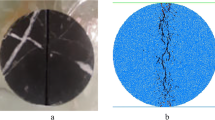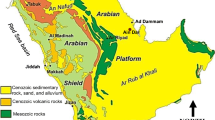Abstract
Studying the mechanical characteristics of weak sedimentary rocks is a burning issue in civil and mining engineering designs and analysis since obtaining rock mechanical properties of these has always faced lots of problems and uncertainties due to the structural weaknesses. One of the main causes of these problems is the difficulty of preparing high-quality core specimens recommended by testing standards or suggested methods for uniaxial compressive strength (UCS). For resolving this issue, in this study, common methods for indirect estimation of UCS of weak rocks were initially studied, their merits and demerits were analyzed, and then, in light of their positive and negative points, a new modified device was designed with a different mechanical structure and force exertion system, which could be practically used to present a new method for indirect estimation of UCS. Thus, in this study, we initially had a general view of the new dynamic needle penetrometer and its modified parts and their capabilities. After introduction, as the first phase of the practical studies on this, dynamic needle penetration resistance (DNPR) was measured, as the dynamic needle penetrometer test result, from 65 specimens collected from three different projects. Then, the relationships between DNPR and UCS of the rock specimens and the regressions of correlations were statistically analyzed. Finally, a linear equation with considerable accuracy resulted from analysis, and using this led to solving the main problem of this research by proposing a developed method for indirect estimation of uniaxial compressive strength of weak rocks.







Similar content being viewed by others
References
ASTM Standard A231/A231M (2010) Standard specification for chromium-vanadium alloy steel spring wire. doi:10.1520/A0231_A0231M-10, www.astm.org
ASTM Standard A304 (2011) Standard specification for carbon and alloy steel bars subject to end-quench hardenability requirements. doi:10.1520/A0304-11, www.astm.org
ASTM Standard A681 (2008) Standard specification for tool steels alloy. doi:10.1520/A0681-08, www.astm.org.
ASTM Standard D5731 (2008) Standard test method for determination of the point load strength index of rock and application to rock strength classifications. Doi: 10.1520/D5731-08, www.astm.org
Aydan Ö, Watanabe S, Tokashiki N (2008) The inference of mechanical properties of rocks from penetration tests. In: Proceedings of the 5th Asian Rock Mechanics Symposium (ARMS5), Tehran, Iran, vol. 1, pp. 213–220
Aydin A, ISRM (2008) Suggested method for determination of the Schmidt hammer rebound hardness: revised version. Int J Rock Mech Mining Sci. doi:10.1016/j.ijrmms.2008.01.020
Bahrami M, Parvanehnezhad Shirazi M (2010) Microfacies and sedimentary environments of Gurpi and Pabdeh formations and the type of Mesozoic–Cenozoic boundary in Fars province, Iran. J Appl Geol Winter 5(4):330–335
Cevik A, Sezer EA, Cabalar AF, Gokceoglu C (2011) Modelling of the uniaxial compressive strength of some clay-bearing rocks using neural network. Appl Soft Comput 11(2):2587–2594
Erguler ZA, Ulusay R (2009) Water-induced variations in mechanical properties of clay-bearing rocks. Int J Rock Mech Min Sci 46(2):355–370
Gokceoglu C, Aksoy H (2000) New approaches for the characterization of clay-bearing, densely jointed and weak rock masses. Eng Geol 58(1):1–23
Gokceoglu C, Ulusay R, Sonmez H (2000) Factors affecting durability of the weak and clay-bearing rocks selected from Turkey with particular emphasis on the influence of the number of drying and wetting of cycles. Eng Geol 57(3–4):215–237
Humboldt Mfg Corporation (2003) Soil penetrometer: model H-4200 product manual. IL, USA
Ismail A, Al-Juboury A (2009) The Upper Miocene Injana (Upper Fars) formation of Iraq: insights on provenance history. Arab J Geosci 2:337–364. doi:10.1007/s12517-009-0045-1
ISRM (2007) The complete ISRM suggested methods for rock characterization, testing and monitoring: 1974–2006. Suggested methods prepared by the Commission on Testing Methods, International Society for Rock Mechanics, Ulusay R, and Hudson JA (eds.), compilation arranged by the ISRM Turkish National Group, Ankara, Turkey, 628 p
Maruto Corporation (2006) Penetrometer for soft rock: model SH-70 instruction manual. Tokyo, Japan
Minaeian B, Ahangari A (2011) Estimation of uniaxial compressive strength based on P-wave and Schmidt hammer rebound using statistical method. Arab J Geosci. doi:10.1007/s12517-011-0460-y
Ngan-Tillard DJM, Engin HK, Verwaal W, Mulder A, Ulusay R, Erguler ZA (2012) Evaluation of micro-structural damage caused by needle penetration testing. Bull Eng Geol Environ 71:487–498. doi:10.1007/s10064-012-0430-y
Ngan-Tillard DJM, Verwaal W, Maurenbrecher PM, Paassen LA van (2009) Microstructural degradation of Maastrichtian limestones. In: Proceedings of Eurock 2009, Engineering in Difficult Ground Conditions Soft Rocks and Karst Leiden, CRC Press, pp. 321–326
Ngan-Tillard DJM, Verwaal W, Mulder A, Engin HK, Ulusay R (2011) Application of the needle penetration test to a calcarenite, Maastricht, the Netherlands. Eng Geol 123:214–424
Potter PE, Maynard JB, Pryor WA (1980) Sedimentology of shale. Springer, New York
Saket A (2006) Sedimentary rocks of Iran, Department of Geology, National Geosciences’ Database of Iran (in Persian). http://www.ngdir.ir/GeoportalInfo/PSubjectInfoLists.asp?PID=598
Tavakoli-Shirazi S et al (2012) Evaluation of Cretaceous–Paleogene boundary based on calcareous nannofossils in section of Pol Dokhtar, Lorestan, southwestern Iran, Pre-Permian uplift and diffuse extensional deformation in the High Zagros Belt (Iran): integration in the geodynamic evolution of the Arabian plate. Arab J Geosci. doi:10.1007/s12517-012-0542-5
Ulusay R, Erguler ZA (2007) Estimation of uniaxial compressive strength of clay-bearing weak rocks using needle penetration resistance. In: Ribeiro e Sousa L, Olalla C, Grossmann N (eds) The second half century of rock mechanics,11th Congress of the International Society for Rock Mechanics. Taylor and Francis, London, Chapter 57, print ISBN: 978-0-415-45084-3, ebook ISBN: 978-0-415-88954-4
Ulusay R, Gokceoglu C (1997) The modified block punch index test. Can Geotech J 34:991–1001
Author information
Authors and Affiliations
Corresponding author
Appendix
Appendix
Additional information about 65 rock samples
Rights and permissions
About this article
Cite this article
Azadan, P., Ahangari, K. Evaluation of the new dynamic needle penetrometer in estimating uniaxial compressive strength of weak rocks. Arab J Geosci 7, 3205–3216 (2014). https://doi.org/10.1007/s12517-013-0921-6
Received:
Accepted:
Published:
Issue Date:
DOI: https://doi.org/10.1007/s12517-013-0921-6




